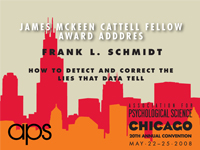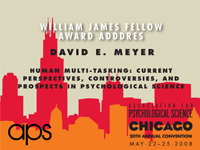Sex Differences, Aging: The Psychological Science in the Public Interest Symposium
Reports published in the APS journal Psychological Science in the Public Interest (PSPI) are produced by teams of scholars from different perspectives — and sometimes different disciplines — whose mission is to produce a consensus on a socially or politically relevant topic about which our science has something to contribute.

There are few more hot-button topics than that of sex differences. APS Fellow and Charter Member Diane F. Halpern, Claremont McKenna College, led the development of the PSPI report “The Science of Sex Differences in Science and Mathematics.” She acknowledged the difficulty in getting a group of eminent researchers from across the disciplinary spectrum to agree on how to even begin interpreting the complex data that potentially bear on the controversial question of the gender gap in the so-called STEM (for science, technology, engineering, and math) fields.
To sort it all out, Halpern’s team examined the data in a range of areas, including cognitive, developmental, and evolutionary psychology, in addition to education and neuroscience. Halpern summarized data showing sex differences in episodic memory (favoring females) and robust, culturally universal differences in reading and writing ability (also favoring females), as well as differences in visual-spatial abilities, especially mental rotation (strongly favoring males) — differences that have frequently been argued to influence the educational success and career trajectories of men and women. Evolutionary psychologists in the team suggested an adaptive role enhanced visual-spatial ability in males may have played in ancestral, hunter-gatherer environments (e.g., hunting and warfare) — although this was one area, Halpern said, in which the team did not come to full agreement.
Social factors operating in our own time clearly also play a role in the observed differences: Parental expectations, self-concept, and popularly held views about the relative aptitudes and weaknesses of women and men in different pursuits have been shown to have strongly self-confirming power. The notion that men are better at science is nothing if not stereotypical, and the large literature on “stereotype threat” shows that stereotypes can have strong short-term effects on test scores — although the significance of these data was another area in which the team had trouble agreeing. Halpern also described a compelling study from Sweden, the most overtly gender-equal country in the world, which showed strong covert discrimination hindering access of women scientists to prestigious fellowships.
The oft-hyped differences between male and female brains (such as overall brain size) are also difficult to interpret. Halpern discussed the passionate debate over the relative size in male and female brains of the corpus callosum, the bundle of nerve fibers through which the two hemispheres communicate (what she called “the corpus callosum wars”; the team’s conclusion: “It may be more bulbous in females”). But what we now know about the lifelong plasticity of the brain in response to experience makes causal conclusions even about such differences in “hard wiring” very difficult to draw.
“There is no single or simple answer,” Halpern said, responding to the question of why there have been and continue to be so many fewer women in STEM fields, adding that she recognized her team’s conclusions will disappoint many readers. “We conclude that early experience, biological factors, educational policy, and cultural context affect the number of women and men who pursue advanced study in science and math, and these effects add and interact in complex ways.”
Cognitive Development in
Older Age

Accounting for differences between men and women, boys and girls, has a long history and has produced mountains of data. By comparison, interest in cognitive development in older age is relatively new. The next speaker, APS Fellow and Charter Member Christopher Hertzog, Georgia Institute of Technology, discussed his team’s conclusions in a forthcoming PSPI report on cognitive enrichment effects across the lifespan. The notion that memory loss and other forms of cognitive deterioration may be controlled by exercising the brain is prevalent among older adults, Hertzog said. “Use it or lose it,” in other words. This belief has spawned a growing market in software, video games, and other tools to promote mental activity and maintain the brain. But hope springs eternal — are crosswords and Sudoku really fountains of cognitive youth?
As with the study of sex differences, there is so far only limited consensus on this question, and it seems to depend partly on how you design your studies. Cross-sectional studies (comparing different individuals at a given point in time) have found strong associations between levels of mental and social activity and measures of general cognitive ability. But such associations do not necessarily say much about what causes what, so it is difficult to draw conclusions from such studies about whether activity leads to preservation of mental abilities in old age. Some researchers using cross-sectional data, he said, have found little support for the “use it or lose it” notion.
Better evidence for enrichment effects comes from longitudinal data (tracking individuals over time), Hertzog said. Social engagement and various kinds of mental activity are shown to predict cognitive change over time, for instance in memory ability. And intervention studies show that training older adults in particular cognitive tasks may produce positive effects, although training doesn’t transfer well across tasks in older individuals. Hertzog suggested that the benefits of engagement in old age may be greater the earlier in life it is begun, by altering the overall trajectory of cognitive development across life and deflecting the general pattern of decline.
Hertzog pointed out that personality differences are likely an important factor: Neuroticism and loneliness are associated with greater risks for decline, whereas optimism is associated with more positive outcomes. In other words, having an attitude or approach to life that encourages social contact and mental engagement may be a crucial element in promoting successful aging.
Where there is a clearly stronger link between activity and mental function is in the area of physical activity. The clearest positive benefits on the aging brain, Hertzog said, have been found for aerobic exercise, which produces broad benefits across many cognitive (as well as physical-health) variables. Executive functions show a large benefit from exercise regimens, for example.
“Evidence is mounting,” Hertzog concluded, “that various kinds of activity — what we might call an engaged lifestyle — is in fact enriching cognition for older adults.” Further research will be necessary, he said, not only to devise successful interventions but also to assess the effectiveness of products marketed to promote mental activity.




APS regularly opens certain online articles for discussion on our website. Effective February 2021, you must be a logged-in APS member to post comments. By posting a comment, you agree to our Community Guidelines and the display of your profile information, including your name and affiliation. Any opinions, findings, conclusions, or recommendations present in article comments are those of the writers and do not necessarily reflect the views of APS or the article’s author. For more information, please see our Community Guidelines.
Please login with your APS account to comment.